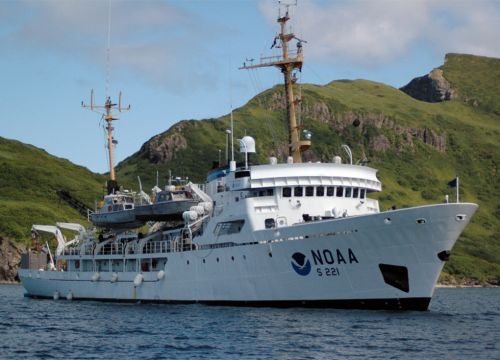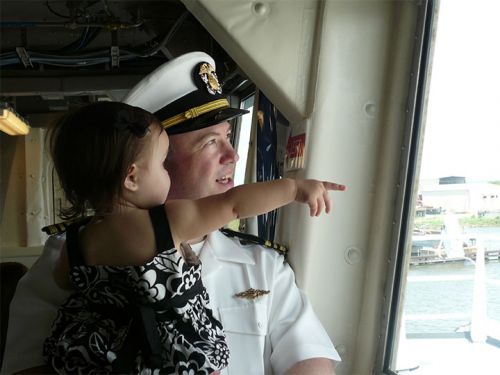Life at Sea or Scientist on Land: NOAA Corps Offers Both

By Cmdr. Jesse Stark, NOAA Corps
March 14, 2017 - A life at sea, or a career conserving natural resources?
That was the choice I was contemplating while walking along the docks in Port Angeles, Washington, back in 1998. A chance encounter that day with the chief quartermaster of National Oceanic and Atmospheric Administration Ship Rainer showed me I could do both.
Growing up in the Pacific Northwest I spent my time exploring the woods, beaches, and tide pools. Every summer I reread Jack London's “The Sea Wolf”, and Herman Melville's “Moby Dick.” My first job was a as a deck hand on charter fishing boats out of Port Angeles.

So, when Quartermaster Bernie Greene invited me aboard that day and told me stories with a sense of adventure, I signed onto the Rainer as an able-bodied seaman, and we headed to Alaska. That first voyage had me hooked and I joined NOAA Corps, leading to my current assignment as the Northwest scientific support coordinator.
NOAA has a long history of supplying scientific support to oil spills, starting with the Argo Merchant incident in 1976, and NOAA Corps history stretches back even farther to President Thomas Jefferson’s order for the first survey of the nation’s coast.
Today, the corps’ commissioned officers command NOAA's fleet of research and survey vessels and aircraft, and also rotate to serve within each of NOAA's other divisions. That combination of duties offers a breadth of experience that I draw upon in my current post in NOAA's Office of Response and Restoration's Emergency Response Division.
In the event of an oil spill or chemical release, the U.S. Coast Guard has the primary responsibility for managing clean-up activities; the scientific support coordinator’s role is to provide scientific expertise and to communicate with other affected agencies or organizations to reach a common consensus on response actions.
During my 18-year career as a corps officer, I’ve had eight permanent assignments, four on ships and four on land in three different NOAA divisions. Those different assignments allowed me to develop skills in bringing resources and differing perspectives together to work toward a common goal. Often, operating units get stagnant and stove-piped, and having new blood with new perspective and outlook rotating through alleviates some of that.
It’s also enabled me to build relationships across different divisions and tie together processes and practices among the different operating units, and sometimes, competing ideologies.
As an example, my first land assignment was with NOAA Fisheries’ Protected Resources Division in Portland, Oregon. While there, I produced a GIS-based distribution map of each recorded ocean catch of salmon and steelhead by watershed origin. While this project involved mainly technical aptitude and data mining, I was also involved with writing biological opinions on research authorizations of endangered salmon species.
This required coordination of many competing and differing viewpoints on management of these species. Consensus had to be reached and often an impasse had to be broken among people with deep passions on these issues.
One of my most challenging assignments was in 2010 when I was executive officer of NOAA Ship Pisces that responded to the Deepwater Horizon oil spill.
During the Deepwater Horizon response, the normal collecting of living marine resource data was replaced with a new process of collecting water and sediment samples better suited to the situation. The incident also showed how industry and government can, and must, work side by side for the good of the public and natural resources.
All of these skills together are proving to come in handy as a science coordinator, where in any given situation there can be as many as five different federal agencies, three state agencies, and several private companies with differing opinions. I’m happy to put my skills and experiences to good use in teamwork building and consensus for the greater good.
Commander Stark joined NOAA’s Emergency Response Division in August 2016. Stark’s previous assignment was commanding officer of the NOAA ship Oscar Dyson in Alaska. Stark started in NOAA as a seaman on the NOAA Ship Rainer in 1998 and was commissioned into the NOAA Corps in 1999.
